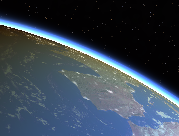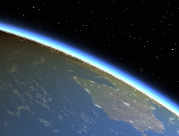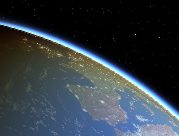Graphics performance
The Gaia Sky uses OpenGL to render advanced graphics and thus its performance may be affected significatively by your graphics card. Below you can find some tips to improve the performance of the application by tewaking or deactivating some graphical effects.
Graphics quality setting
Please see the Graphics quality section.
Star brightness
The star brightness setting has an effect on the graphics performance because it will cause more or less stars to be rendered as quads instead of points, which means multiplying the number of vertices to send to the GPU. Quads are basically flat polygons to which a texture is applied (in this case their appearance is controlled by a shader).
The star brightness can be increased or decreased from the
Star brightness slider in the Visual settings section.
Hint
Ctrl + d - activate debug mode to get some information on how many stars are currently being rendered as points and quads as well as the frames per second, frame time and more.
Star groups
Star groups are an internal concept in Gaia Sky. Usually, a single catalog is loaded into a single star group, but it is not always the case. The main exception are the level-of-detail catalogs. In these, each octree node (octant) has a different star group.
A number of quantities are limited at the star group level. These are the maximum number of billboards, the maximum number of labels and the maximum number of velocity vectors. All of these quantities have a rather strong impact on performance.
Billboards
Stars, when close to the camera, are rendered with high quality billboards. Billboards are images which always face the camera (i.e. their normal vector is aligned with the vector that joins the camera position with the object’s position).
The number of stars that will be rendered as billboards has a strong impact
on performance, as we need to compute the quaternions to rotate the images correctly.
This number is capped to a maximum value set in the
configuration file. This number is set to 30 stars per star group by default, but you can
edit it by editing the following line in your global.properties file.
# Maximum number of billboards per star group
scene.star.group.billboards=30
Labels
Object labels or names in the Gaia Sky are rendered using a special
shader which implements distance field
fonts. This means that
labels look great at all distances but it is costlier than the regular
method.
The label factor basically determines the stars for which a label will
be rendered if labels are active. It is a real number between 1 and 5,
and it will be used to scale the threshold point angle (which
determines the boundary between rendering as points or as quads)
to select whether a label should be rendered or not.
The label is rendered if the formula below yields true.
viewAngle > threshold_angle_point / label_factor
The label number factor impacts how many labels are displayed. You can modify this
value by editing your global.properties file.
# Label number factor. Controls how many stars have labels
scene.label.number=1.3
Additionally, the maximum number of labels per star group is also defined in the configuration file. The default value is 50.
# Maximum number of labels per star group
scene.star.group.labels=50
Velocity vectors
When active, velocity vectors can become a big toll on performance. To mitigate that, you can adjust the number of vectors shown using the slider at the bottom of the type visibility pane.
Moreover, the maximum number of velocity vectors per star group is defined in the configuration file. The default value is 500.
# Maximum number of velocity vectors per star group
scene.star.group.velocityvectors=500
Model detail
Some models (mainly spherical planets, planetoids, moons and asteroids)
are automatically generated when the Gaia Sky is initializing and
accept parameters which tell the loader how many vertices the model
should have. These parameters are set in the json data files and can
have an impact on devices with low-end graphics processors. Let’s see an
example:
{
"model" : {
"args" : [true],
"type" : "sphere",
"params" : {
"quality" : 150,
"diameter" : 1.0,
"flip" : false
},
"texture" : {
"base" : "data/tex/neptune.jpg",
}
}
}
The quality parameter specifies here the number of both vertical and
horizontal divisions that the sphere will have.
Additionally, some other models, such as that of the Gaia spacecraft,
come from a binary model file .g3db. These models are created using
a 3D modeling software and then exported to either .g3db (bin)
or .g3dj (JSON) using
fbx-conv. You can create
your own low-resolution models and export them to the right format. Then
you just need to point the json data file to the right low-res model
file. The attribute’s name is model.
{
"model" : {
"args" : [true],
"model" : "data/models/gaia/gaia.g3db"
}
}
Bloom, lens flare and light glow
All post-processing algorithms (those algorithms that are applied to the image after it has been rendered) take a toll on the graphics card and can be disabled.
Hint
Disable the light glow effect for a significant performance boost in low-end graphics cards
The bloom is not very taxing on the GPU.
The lens flare effect is a bit harder on the GPU, but most modern cards should be able to handle it with no problems.
The light glow effect is far more demanding, and disabling it can result in a significant performance gain in some GPUs. It samples the image around the principal light sources using a spiral pattern and applies a light glow texture which is rather large.
To disable these post-processing effects, find the controls in the UI window, as described in the [[lighting|User-interface#lighting]] section of the [[User interface]] chapter.
Antialiasing
Antialiasing is a term to refer to a number of techniques for reducing jagged edges, stairstep-like lines that should be smooth. It reduces the jagged appearance of lines and edges, but it also makes the image smoother. The result are generally better looking images, even though this depends on the resolution display device.
There are several groups of anti-aliasing techniques, some of them implemented in the Gaia Sky and available for you to choose from the graphics settings. They all come at a cost, which may vary depending on your system.
Name |
Type |
Description |
|---|---|---|
No Antialiasing |
No antialiasing |
This has no cost since it does not apply any antialiasing technique. |
FXAA |
Post-processing |
This has a mild performance cost and produces reasonably good results. If you have a good graphics card, this is super-fast. |
NFAA |
Post-processing |
Based on the creation of a normal map to identify edges, this is slightly costlier than FXAA but it may produce better results in some devices. |
Here are some sample images.
Name |
Image |
|---|---|
No Antialiasing |
|
FXAA |
|
NFAA |
|
Some graphics drivers allow you to override the anti-aliasing settings of applications with some default configuration (usually MSAA or FXAA). You can also use this feature with the Gaia Sky.
Find more information on anti-aliasing in the Antialiasing section.


